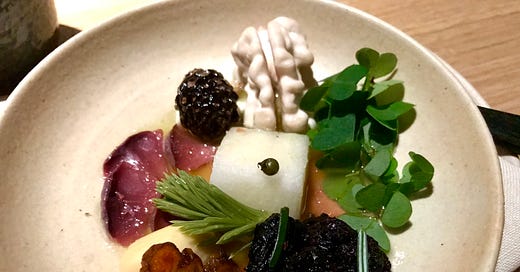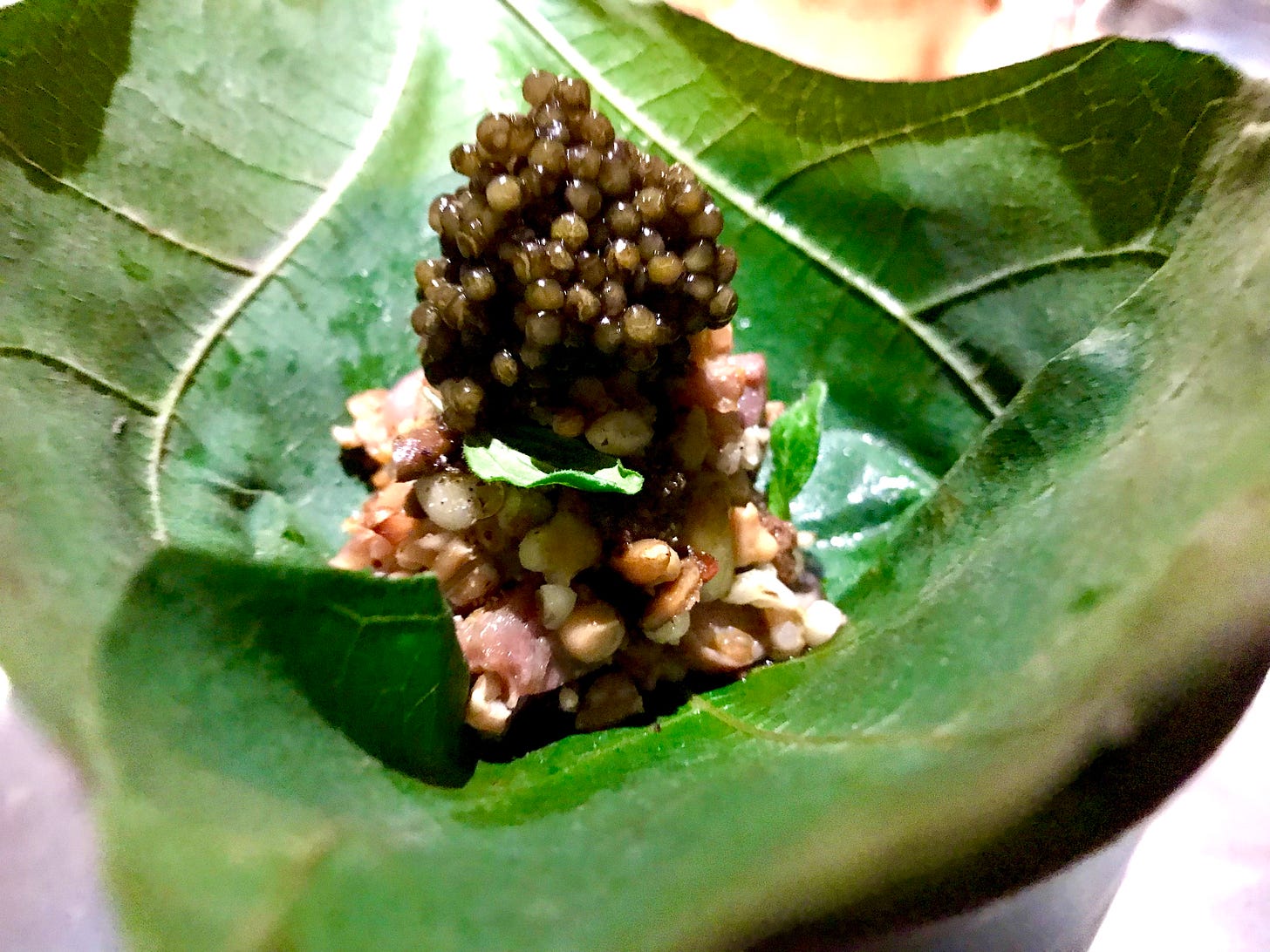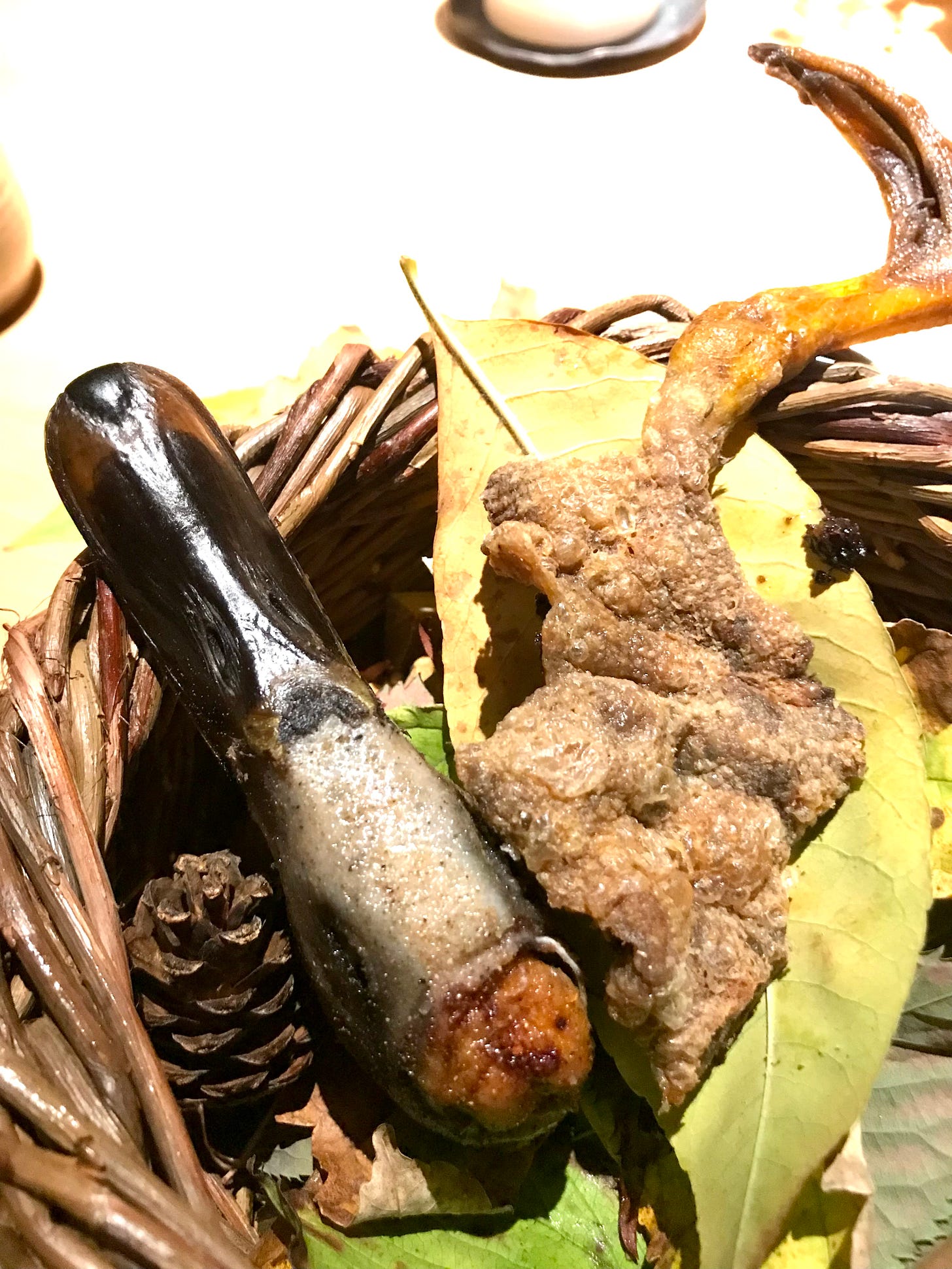The End of Fine Dining?
Why Noma matters. An intriguing old menu. And affordable wine glasses.
Before we begin….
Fourteen months ago, when Substack asked me to be Writer in Residence I said no. I’d been a journalist for most of my life, and I had so much on my plate I didn’t want to commit to a regular column.
“Do it for a month,” they urged. But when the month was over, I felt such a strong connection to this growing community that I just couldn’t quit. And so I have found myself, once again, with a weekly column.
I love everything about writing La Briffe, but the best part is hearing from all of you. I feel as if I’ve made so many new friends. Still, if I’m being honest, a fair amount of work goes into La Briffe, and during the course of my career I have told young journalists, over and over, that their work has value and they should never do it for free.
If you agree - if La Briffe has some value for you - I’m now adding a paid option. If you can’t afford it - or don’t care to - nothing will change. The free option will always remain. But I’d like to continue writing La Briffe, and if it gives you pleasure, please help me keep it going.
About Fine Dining…..
During the Covid lockdown I spent a lot of time talking to chefs as I worked on a documentary about why we eat what we eat, Food and Country. Most of them thought that fine dining would be different when we came out the other side. Dan Barber - one of the most thoughtful people in the food world - said something that really resonated with me. When Blue Hill was in lockdown, and they were producing nothing but “meal boxes,” he found the way his kitchen worked had changed. The old Escoffier model vanished, leaving them with no hierarchy. It was, he said, the first time in his career he was working in a calm kitchen. He loved it, and was convinced that the old model (which is based on the military), would never return.
But it did.
And it is increasingly unsustainable. This week Noma, the restaurant that is generally considered “the best in the world” (whatever that means) announced it will shut its doors at the end of the year.
If you haven’t read Julia Moskin’s article in the NY Times, here it is.
Perhaps we should be applauding. The precision, focus and intensity these restaurants require is insane. Seriously ambitious restaurants often have a 1:1 worker to customer ratio. Employee abuse is rampant. Ingredients cost the earth. Rents continue to rise. Well, you’ve read the stories….
What chefs like Rene Redzepi (and Grant Achatz, Dominique Crenn, Massimo Bottura, Ben Shewry - I could go on) offer us is an entirely new way to experience food, and I have always found that exhilarating. Ferran Adria literally made everyone who thinks about eating look at ingredients in new ways. When I told one of his biographers that I intensely disliked a few of the dishes at El Bulli he replied, “that would make Ferran happy. The restaurant is about much more than pleasure.”
There has been - and there will be - a lot of pontificating about what the closing of Noma means. But looking back, I’m reminded of the early nineties in Los Angeles when the economy tanked and the energy and innovation that made eating in Los Angeles in the eighties so much fun fizzled out. What we ended up with was a series of safe, dull, copycat restaurants. It turned out that a world without talented chefs intent on pushing the envelope is a far less interesting place. .
Five years ago, when the extremely talented Anita Lo closed Annisa in New York, she was the canary in the coal mine. Celebrated by critics, beloved by patrons, sold out every night, she said her restaurant was no longer financially viable. At the time I thought it was an early sign of things to come. Now Rene Redzepi, the most celebrated chef of our time is opting out. Others will follow.
There’s a lot to unpack here, and I’ll be writing about it in more depth in the weeks to come. I’d love to hear your thoughts. But right now I want to look back at a few Redzepi moments. Like the time I interviewed him and David Chang at the New York Public Library. This was my takeaway: don’t miss that terrorist comment!
OCTOBER 7, 2010
Rene Redzepi and David Chang are two of the most thoughtful, charismatic and entertaining chefs today. But speaking with them last night I couldn’t help thinking about the irony of the evening. We were talking about eating culture, about the need to create a truly local cuisine. We all agreed that restaurant cooking has become so homogenized that if you closed your eyes and simply tasted what was on your plate, you would have no way of knowing where in the world you were. You could be eating the same dishes in Sydney, Shanghai, London or San Francisco. For these two young chefs, the creation of a truly local cuisine is the next food frontier.
But while they may be thinking local, they’re living global. David looked exhausted, and he had to run off to catch a plane to London, where he’ll be cooking a meal with Claude Bosi of Hibiscus. Meanwhile Rene’s whistle-stop tour has taken him to three continents in the last two weeks, and he’s still wearing his traveling shoes.
Some more thoughts:
Favorite Moment: Rene pointing out that chefs would make great terrorists, because they’re so single-minded and obsessed. (Although I may have been the only one who laughed.)
Favorite Audience Question: The young chef, who stood up in front of all those people and made a pitch for a stage at Noma next summer. How could Rene say no? He couldn’t, although I suspect he’s opened the door to many more requests along the way.
There were also a few interesting reader comments:
Mvldz says:
October 7, 2010 at 12:20 pm
The talk last night was highly inspirational. It’s amazing to see someone as young as Rene gaining such accolades, and being so miraculously humble about it. His passion came through tenfold in his description and discussion of food; the experience of sharing the moments of chefs picking their first herbs and veggies ever, the thought of him wanting to do right by ingredients, and following along with one of the most spectacular rules of cooking (at least i think so) in regards to if things are growing together (from a seasonal perspective) they (more times then not) pair well together. And he does this to a hyperlocal level of – if it grows within several feet of each other, they most likely go well together as well.
I was a bit shy unfortunately, as I did want to ask how much of the food at Noma is actually foraged, and also what kind of proteins are used at the restaurant, and if the butchering and slaughtering are done in house? — Just sort of, to what extent do they do everything from goods in their most rawest/purest of states?
I definitely know I was laughing (for a bit longer then most around me were comfortable with) about the “chefs making great terrorists” comment…
Chang however did seem exhausted in every level.
twitter.com/cookingwithamy says:
October 15, 2010 at 5:00 pm
I was so impressed with Redzepi and his “back to nature, culture on a plate” philosophy. I found him refreshing and optimistic. Amazing to realize how much his contemporary perspective is inspired by his rural life in Macedonia, practically cut off from the modern world…
And in case you missed it, here’s the interview I did with Rene a couple of months ago, when he was promoting his new cookbook.
Finally, a few pictures from the last meal I had at Noma, beginning with this showstopper: caviar-topped reindeer penis.
We were also served a reindeer skull….
…..containing “a light jelly of reindeer brain”.
I’m not going to go through the entire meal… but this little side dish accompanying the wild duck illustrates the painstaking work that goes into each plate:
What do you think is hiding beneath these leaves?
Why it’s the brain of yet another animal!
For me, however, the biggest revelation of the evening was this dish of foraged foods that included a pinecone and a perfectly white, hand-peeled walnut. The nut apparently takes hours to peel, but the flavor was astonishing.
This menu is probably from the early 2000s, and looking at it I’m reminded that Ruth Rogers of The River Cafe offers us an entirely different way of looking at restaurants. When I interviewed Ruthie five years ago at the Cherry Jubilee (you can listen to our conversation here), she had some very interesting solutions to the problems facing restaurants like Noma.
Pay people well. Offer benefits. But more than that, The River Cafe has eliminated the wall between the front and the back of the house. Everyone comes in to help prep the food: waiters and busboys (often with their kids in tow), peel potatoes, mince garlic, wash lettuce. As a result waiters often become cooks, cooks find they’d rather wait tables and the tension between the two disappears.
I’ve always loved the restaurant’s honest rustic food. But listening to Ruthie talk about her staff made me admire the restaurant even more.
I’m in a rented house for a few months, and each night I find myself missing stemmed wine glasses. To me they make wine taste better. Trolling around the internet I found that my favorite affordable stems from Made In are on sale. They’re the nicest glasses I’ve found at a reasonable price: thin, dishwasher safe, lovely to hold. At the moment the set of 8 glasses (4 white wine and 4 red wine) comes to about $8 a stem. I’ve just ordered a set for my temporary home.

















I'm curious to know if you actually enjoyed the reindeer penis and brain, and the duck brain, so "authentically" presented? All I can think of looking at those photos is the new film, "The Menu," which I think perfectly skewers this kind of culinary absurdity. I appreciate Redzepi's talent, but I will never understand why anyone would pay hundreds of dollars to be served jellied reindeer brain out of a skull.
I went to Noma. They didn't give us any bread and about 1000 glasses of wine. We puked! The most expensive and labor-intensive vomit ever?